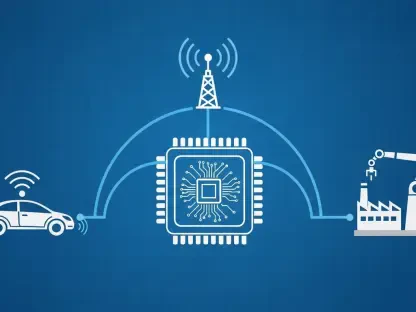Setting the Stage for Broadband Innovation
In an era where high-speed internet is no longer a luxury but a necessity, millions of Americans in rural and underserved areas still grapple with the stark reality of inadequate connectivity, highlighting a critical digital divide. Imagine a small farming community, miles from the nearest city, where students struggle to complete online assignments and businesses falter due to sluggish internet speeds. This digital divide, affecting nearly 30 million people across the nation, underscores a pressing challenge in modern infrastructure. Fixed Wireless Access (FWA) technology emerges as a beacon of hope, promising to deliver gigabit-speed internet without the cumbersome delays and costs of traditional fiber-optic networks. This review dives deep into the mechanics, advancements, and real-world impact of FWA, exploring how it stands poised to reshape broadband access.
Understanding Fixed Wireless Access (FWA) Technology
FWA technology represents a paradigm shift in broadband delivery, leveraging wireless signals to provide high-speed internet without the need for extensive physical cabling. At its core, FWA operates by transmitting data between a base station and a receiver at a customer’s location, bypassing the logistical hurdles of laying fiber over vast or challenging terrains. This approach positions FWA as a vital solution in areas where traditional infrastructure is economically unfeasible or geographically impractical.
The emergence of FWA as a credible alternative stems from the growing demand for rapid, scalable connectivity solutions. Unlike wired networks that require years of planning and construction, FWA can be deployed swiftly, often within days, making it a strategic tool for addressing urgent connectivity gaps. Its relevance is amplified in the context of global efforts to ensure digital equity, particularly in regions long neglected by conventional broadband providers.
This technology also aligns with the evolving needs of diverse user bases, from remote workers to educational institutions, by offering flexibility in deployment and adaptability to varying environmental conditions. As a result, FWA is increasingly recognized as a cornerstone in the quest for universal internet access, challenging the dominance of fiber-centric models with a more agile and inclusive framework.
Core Features and Technical Innovations of FWA
Millimeter-Wave (mmWave) Technology
A standout feature of FWA is its utilization of millimeter-wave (mmWave) technology, which operates in high-frequency bands to deliver exceptional internet speeds. Capable of providing download rates of up to 2.5 Gbps per subscriber, mmWave ensures performance that rivals or even surpasses many fiber connections. This capability is critical for supporting data-intensive applications like 4K streaming or large-scale cloud computing in residential and commercial settings.
The use of licensed spectrum bands, such as those approved by regulatory bodies, enhances the reliability of mmWave-based FWA systems. These bands minimize interference and ensure consistent service quality, a significant advantage over unlicensed wireless options prone to congestion. Such technical precision underscores why FWA is gaining traction as a robust alternative for high-capacity broadband delivery.
Moreover, mmWave technology supports dense user environments through advanced beamforming techniques, focusing signals directly to individual receivers. This innovation maximizes bandwidth efficiency and maintains high-speed connectivity even in areas with numerous simultaneous users, positioning FWA as a forward-thinking solution for urban and suburban challenges alike.
Rapid Deployment and Coverage Capabilities
One of the most compelling advantages of FWA lies in its rapid deployment potential, a stark contrast to the protracted timelines associated with fiber installations. A single base station can cover an expansive area of up to 100 square miles with comprehensive 360-degree coverage, drastically reducing the need for multiple infrastructure points. This scalability is a game-changer for regions requiring immediate connectivity solutions.
Installation at the customer end is equally efficient, often completed in under 30 minutes per site. This speed enables service providers to connect entire communities in a fraction of the time required for traditional wired networks, addressing urgent demands without sacrificing quality. Such efficiency translates into quicker access for end-users and faster returns on investment for operators.
Beyond speed, the reduced need for physical infrastructure like trenching or cable-laying lowers both capital and operational expenditures. This cost-effectiveness makes FWA particularly appealing for rural deployments where low population density renders fiber uneconomical, ensuring that even remote areas can benefit from cutting-edge internet services without prohibitive expenses.
Recent Advancements and Industry Trends in FWA
The landscape of FWA technology is evolving rapidly, driven by innovations such as hybrid massive beamforming, which optimizes signal directionality for enhanced performance. This advancement allows for greater precision in data transmission, ensuring stable connections across varied terrains and user densities. Such technical progress reflects the industry’s commitment to elevating wireless solutions to match or exceed wired benchmarks.
Another notable trend is the strategic partnerships facilitating accessible spectrum leasing, particularly for smaller Wireless Internet Service Providers (WISPs). By collaborating with nationwide license holders, these providers can access high-quality spectrum at reduced costs, democratizing the ability to offer fiber-like speeds. This shift is pivotal in leveling the competitive field and fostering broader adoption of FWA services.
Additionally, the industry is witnessing a departure from a fiber-first mentality, spurred by federal funding initiatives like the Broadband Equity, Access, and Deployment (BEAD) program. These programs emphasize quick, cost-effective connectivity over traditional infrastructure-heavy approaches, aligning perfectly with FWA’s strengths. As a result, wireless solutions are increasingly viewed as long-term strategies rather than temporary fixes, marking a significant cultural shift in broadband planning.
Real-World Applications and Case Studies of FWA
FWA technology is already making tangible impacts across diverse regions, particularly in addressing connectivity challenges in underserved areas. In North America, deployments by major WISPs such as BroadbandOne and GeoLinks showcase FWA’s ability to deliver speeds exceeding 1 Gbps to subscribers in remote locations. These implementations highlight the technology’s role in empowering communities previously left behind by fiber expansion.
On a global scale, Europe offers striking examples of FWA’s scalability, with Italy hosting the largest mmWave FWA network in the world. Serving millions of subscribers, this network demonstrates the technology’s capacity to handle large-scale demand with consistent reliability. Such success stories provide a blueprint for other regions looking to replicate similar outcomes in their connectivity efforts.
These case studies also reveal FWA’s adaptability to varying regulatory and environmental contexts, from densely populated urban fringes to sprawling rural landscapes. By meeting stringent performance benchmarks set by funding programs, these deployments affirm FWA’s potential to bridge digital divides effectively, offering a practical alternative where traditional networks fall short.
Challenges and Limitations Facing FWA Adoption
Despite its promise, FWA faces several hurdles that temper its widespread adoption. Historical barriers to accessing licensed spectrum have long constrained smaller operators, limiting their ability to compete with established players. While recent partnerships have alleviated some of these issues, navigating regulatory complexities remains a persistent challenge for many providers.
Technical limitations also pose concerns, particularly in maintaining consistent reliability across diverse environmental conditions. Factors such as weather interference or physical obstructions can impact signal quality, necessitating ongoing innovation to ensure robust performance. Addressing these vulnerabilities is crucial for building trust in FWA as a dependable broadband solution.
Competition with entrenched fiber networks further complicates FWA’s market penetration, as many stakeholders remain skeptical of wireless alternatives despite their proven capabilities. Overcoming this bias requires not only technological advancements but also sustained advocacy to highlight FWA’s economic and logistical benefits. Collaborative efforts between industry leaders and policymakers are essential to shift perceptions and foster broader acceptance.
Future Prospects and Potential of FWA Technology
Looking ahead, FWA technology is poised for significant growth, with projections indicating expanded deployments across both rural and urban settings over the coming years, from now through 2027. Anticipated breakthroughs in wireless capabilities, such as enhanced spectrum efficiency, promise to further elevate FWA’s performance, potentially matching fiber in even more scenarios. This trajectory suggests a future where wireless connectivity becomes a primary rather than secondary option.
The potential for FWA to complement fiber in a hybrid connectivity model offers a balanced approach to achieving universal broadband access. By integrating the strengths of both technologies—FWA’s speed of deployment and fiber’s raw bandwidth—stakeholders can craft tailored solutions for diverse geographic and demographic needs. This synergy could redefine global strategies for closing digital gaps.
Moreover, as funding and policy support continue to prioritize rapid connectivity, FWA stands to play a central role in shaping inclusive internet policies. Its ability to deliver immediate results in unserved areas positions it as a critical tool for policymakers aiming to meet ambitious digital equity goals, ensuring that no community is left disconnected in an increasingly online world.
Reflecting on FWA’s Journey and Path Forward
Looking back, the journey of Fixed Wireless Access technology has proven its mettle as a formidable contender in the broadband arena, challenging the long-standing dominance of fiber with remarkable speed and efficiency. Its ability to deliver gigabit speeds, coupled with rapid deployment, has carved out a vital niche in connecting the unconnected. The real-world successes in North America and Europe have underscored its reliability and scalability, setting a precedent for future endeavors.
Moving forward, the focus should pivot to actionable strategies that amplify FWA’s reach, such as fostering more spectrum-sharing agreements to empower smaller providers. Investment in research to mitigate environmental interferences could further solidify its standing as a resilient solution. Additionally, educating stakeholders on the complementary nature of FWA alongside fiber could drive hybrid models that maximize coverage and performance, ensuring that the momentum gained continues to transform lives across diverse landscapes.









